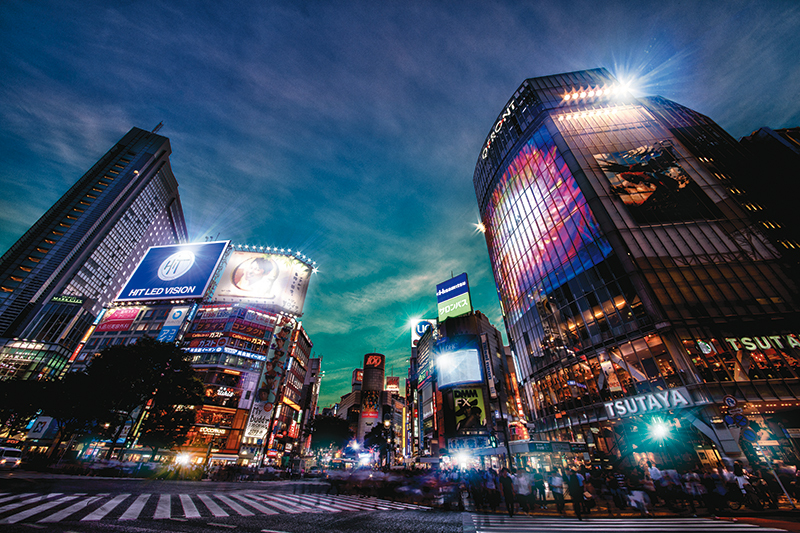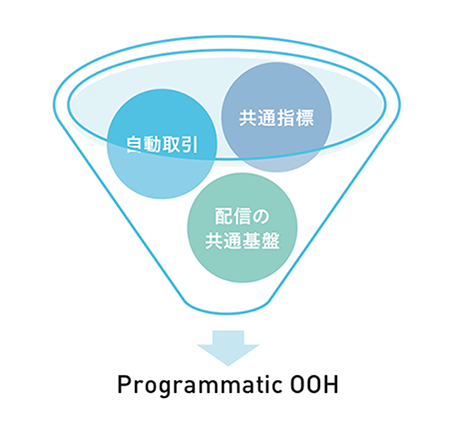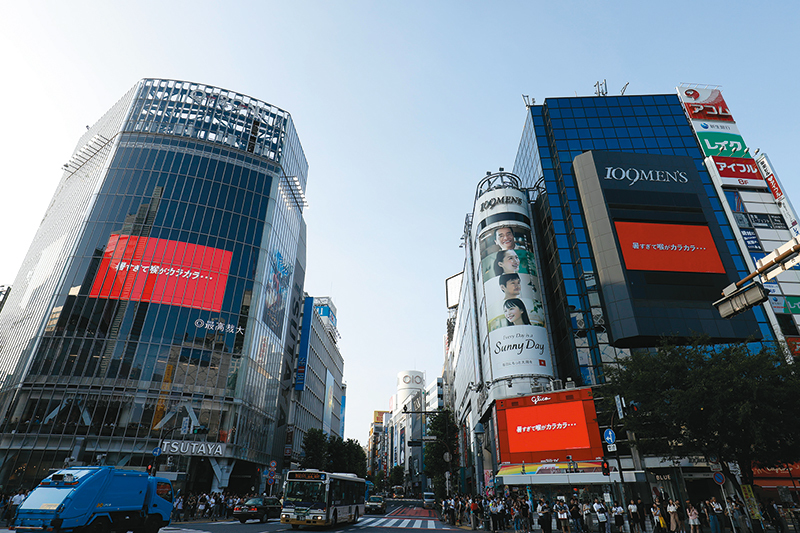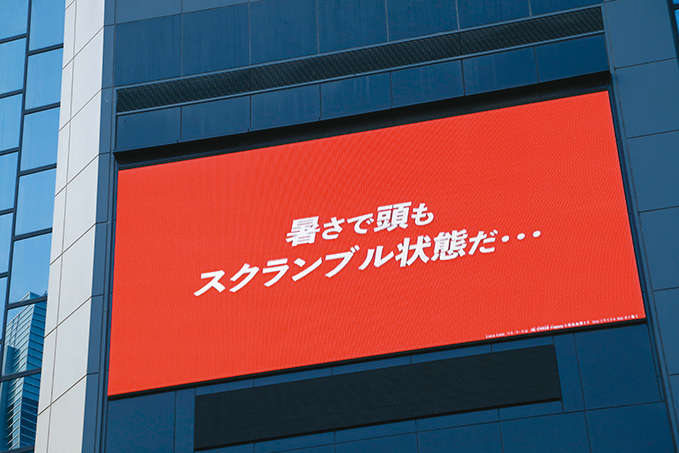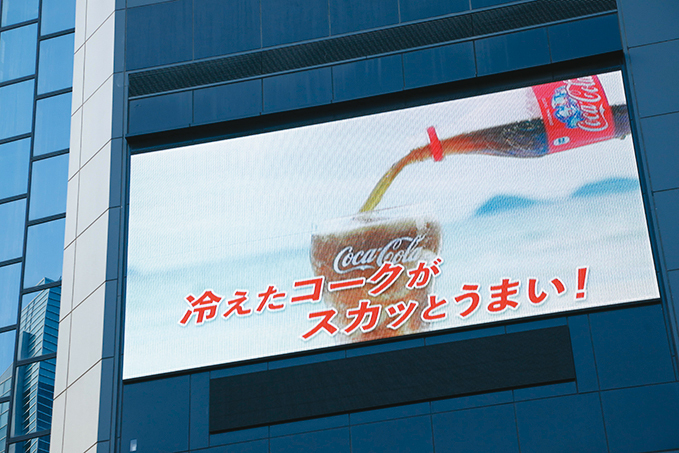The digital transformation of OOH, including outdoor and transit advertising, is accelerating. Amid this trend, cases are emerging where programmatic OOH—enabling the automatic delivery of messages that resonate with audiences—is achieving high results. We explored the cutting edge of this old yet new OOH.
Digital OOH in Japan is expected to see significant growth.
The digital shift is accelerating in the OOH world, which encompasses all advertising outside the home. The most representative areas are outdoor advertising and transit advertising. The global market for digital OOH (DOOH) has a CAGR (Compound Annual Growth Rate) of 13.2% (※1), while the Japanese market has a CAGR of 27.8% (※2), indicating significant growth potential (2013-2020). One study (※3) suggests DOOH's growth potential through 2021 is 86%, surpassing mobile's 67% and online's 49%.
Issues currently plaguing digital advertising—such as ad fraud creating unhealthy media supply chains and hate content threatening brand value—are irrelevant to OOH, making it a reassuringly reliable medium. This reliability is another point driving its reevaluation.
Above all, DOOH's digital nature enables it to create experiences that are "right now, in this moment" and "only here," making it highly compatible with social media. Furthermore, by integrating with various data sources, it can deliver emotionally resonant experiences tailored to specific situations. The emergence of "programmatic OOH," which automates these processes and advertising transactions, combined with unprecedented data accessibility, now enables the efficient delivery of impactful and effective advertising.
(※1) 2016 Peter J. Solomon Company Wall,
(※2) 2015 Fuji Chimera Research Institute, Survey on Digital Signage,
(※3) 2016 Ocean Outdoor, "From Paper & Paste to Pixels & Playouts"; Dentsu Inc. "2016 Japan Advertising Expenditure"
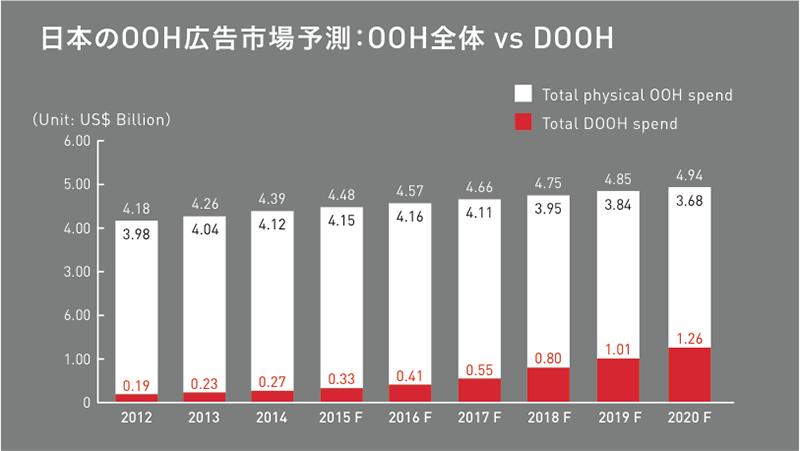
Source: 2016 Dentsu Advertising Expenditure of Japan for 2014, 2015 Fuji Chimera Research Institute, Survey on Digital Signage
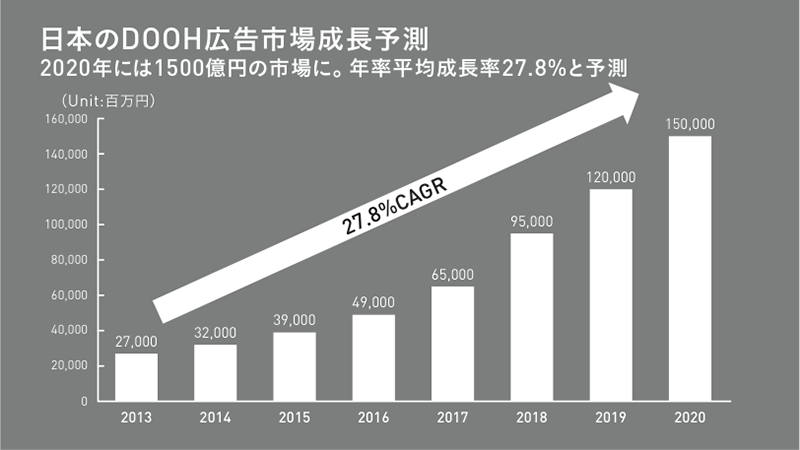
Source: 2015, Fuji Chimera Research Institute
Programmatic OOH, capable of creating "right now, this moment" and "only here" experiences, powerfully drives action within the customer journey.
While OOH's possibilities continue to expand, its appeal is simple.
"The best thing about OOH is undoubtedly its 'forced visibility'. With the rise of social media, the advertising landscape has changed, making it harder to create shared conversations. OOH, however, can provide that shared talking point when people are out and about. This is a point that deserves more attention. Also, the impression from seeing the same ad on the way home from work versus when heading out for fun on a day off is completely different. While OOH media has been around for a long time, by aligning with what's happening right there, right then, it enables fresh expression," says Hamada.
And with digitalization and programmatic advertising, its value has skyrocketed.
"Programmatic OOH is often perceived as an industry innovation—automated ad delivery and trading—but the real beneficiaries are consumers. Programmatic OOH can spark latent needs and insights. For instance, psychological states shift based on location and time, allowing people to genuinely appreciate a product's true value. Through creative seen in that state, they might 'discover' they've always wanted that car, enriching their lives or stepping into a new lifestyle. I believe the true value of programmatic OOH lies in amplifying the consumer's 'now' and 'here' – it's the 'Power of Now' and the 'Power of Here'." (Mr. Kaminai)
Three Challenges the Industry Must Unite to Overcome
While programmatic OOH offers shared conversation topics through "forced visibility" and embodies the "Power of Now" and "Power of Here" by connecting with consumers, it also faces challenges. These can be broadly categorized into three main areas:
① Common metrics to measure advertising effectiveness
② Automated ad space trading
③ A common platform for ad delivery
① Common Metrics: Currently, metrics vary widely by medium, such as transit ads or outdoor ads. While advertisers and planners prioritize reach (ad exposure rate) and frequency (ad contact rate within a period), current metrics focus on circulation (total potential passersby) at stations or roads, or passenger counts. Diary-style surveys sometimes capture audience data, but the cost is a significant burden.
"In the UK, there is an audience research system called 'Route'. It has equipped over 50,000 cumulative monitors with compatible devices to automatically collect location data, enabling the calculation of Reach × Frequency at specific locations and times. We are exploring the possibility of creating a Japanese version of this system. Additionally, since December 2016, we have been providing 'Machilog,' which utilizes mobile spatial statistics data. This solution combines and analyzes various information based on 250-meter mesh audience data derived from mobile carrier base station information, enabling downscaling to 25-meter meshes. This makes it possible to quantify and visualize outdoor advertising circulation—previously difficult to measure—by gender, age group, day of the week, and time of day. It allows for dynamic and detailed understanding of audience behavior data, which varies significantly by time and day, enabling its effective use in planning. Currently available in two locations, Shibuya and Omotesando, we plan to expand to major downtown areas in seven key regions nationwide." (Mr. Hamada)
Regarding point ②, automated trading faces unique challenges in Japan. Securing an 80% share of outdoor advertising requires agreements with over 1,000 media companies. Even combining the shares of 11 railway companies in the Kanto region for transit advertising falls short of 50%. Each company individually manages these available slots, and submission systems for various digital signage formats differ, creating enormous operational burdens. Even if advertisers want to use programmatic OOH, only a very limited number of slots are currently available. "Beyond the metrics mentioned earlier, standardizing transaction flows is the first step in improving the environment," states Mr. Hamada. This is a shared understanding among those involved in OOH.
Regarding ③, the delivery infrastructure currently relies predominantly on locally closed systems, with few allowing real-time external connections. Consequently, static delivery methods—where pre-prepared content is broadcast at predetermined times for fixed periods—have been the norm. Enabling constant external connectivity would allow for dynamic content delivery utilizing third-party data in real time.
"Enabling dynamic ad delivery allows us to connect not just with the location, but with the audience's current mindset. One study (※4) comparing spontaneous recall, message recall, and citation rates between traditional DOOH and dynamic DOOH found the latter to be overwhelmingly more effective. Notably, the citation rate for social media sharing increased by 173%," (Mr. Kaminai)
However, a key challenge is the need for a separate delivery system distinct from existing digital ad servers.
"Given current network conditions, content must be downloaded and stored locally beforehand. While smartphones and PCs will wait for content to load, OOH doesn't allow that. Also, since no one clicks on OOH ads, systems that charge based on clicks can't be used. Even if automated, defining an impression is difficult because many people see that single ad. Therefore, establishing common metrics, automated trading, and the delivery infrastructure must be done centrally," said Mr. Kamauchi.
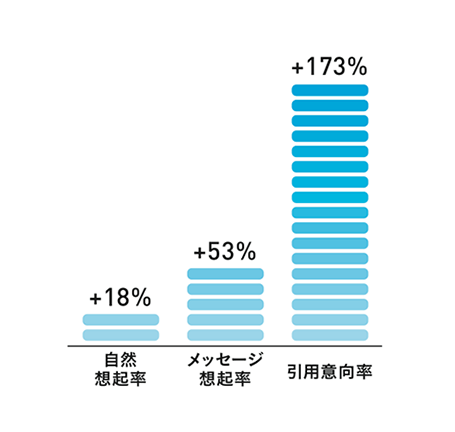
(※4) "Effectiveness of Dynamic DOOH Compared to Traditional DOOH" (January 2015, VirtuoCity Research)
Anticipating Creator Participation as a New Creative Platform
Furthermore, Mr. Hamada anticipates the emergence of creators willing to challenge this new field of programmatic OOH.
"No matter how well the system is set up, I truly feel that only creators can come up with truly interesting concepts. I want everyone to get excited about creating work that masterfully crafts those 'love at first sight' moments—the kind where you think, 'If I encountered this right here, right now, I'd fall for it instantly.' Going forward, this medium will powerfully drive actions in the customer journey—like making you buy the product, download it, or just go there—so it will undoubtedly become a new creative space for creators."
OOH, whose origins are said to date back to cave paintings estimated to be 40,000 years old on Sulawesi Island, Indonesia. This ancient yet new advertising method is impossible to look away from.
Three Essential Conditions to Accelerate Programmatic OOH
① Shared Will with Advertisers and Media Companies
Challenges like establishing common metrics, improving transaction environments, and automating delivery will only accelerate once people actually try it and feel, "This is convenient," or "This is interesting." Good examples are emerging, so we want to actively share these success stories and engage everyone in solving the challenges.
② Participation of Creators Who Can Leverage Its Unique Characteristics
We want creators who find new fields exciting to pursue expressions unique to Dynamic DOOH. By utilizing external data, it becomes possible to create expressions unlike anything before, specific to that time and place. We want them to create expressions that are different from commercials, different from conventional digital signage—expressions that make you think "Wow, that's how it works!" right there, at that moment.
③ Keeping an eye on tech trends like AI
While not mentioned in the main text, AI adoption is remarkable in this field. For instance, in traffic surveys, attempts are underway to dynamically price media value by identifying vehicle models and model years. Such technologies enhance the value of programmatic OOH and open new frontiers in marketing. For those eager to test cutting-edge tech, why not try it with OOH?
Programmatic OOH is here!
Large-scale examples of programmatic OOH, capable of creating "right now, this moment" and "only here" experiences, are starting to emerge.
One example is Coca-Cola System's "Hot Summer? Ice-Cold Coke!" campaign.
From July 17 to August 27, messages tailored to each location, time of day, and the day's temperature were displayed in Tokyo, Osaka, Nagoya, Sapporo, and Fukuoka.
For example, at Shibuya's Scramble Crossing, messages like "The heat's scrambling your brain..." and "Someone give Hachiko some water..." were displayed, speaking directly to the situation at that time and place. This programmatic delivery enabled OOH campaigns where the product truly resonated with consumers' immediate environment.
This summer, The Coca-Cola Company System ran a campaign themed "The hotter the summer, the colder the Coke!" Across various consumer touchpoints—from TV commercials to digital, social media, and events — the campaign communicated "the deliciousness of ice-cold Coca-Cola on a hot summer day. "
As part of this effort, it launched Japan's first large-scale programmatic OOH campaign. Across five major cities nationwide, it maximized advertising effectiveness by dynamically delivering over 150 types of optimized creative content—including messages and videos—in real-time based on area, weather, temperature, time, and local events.


